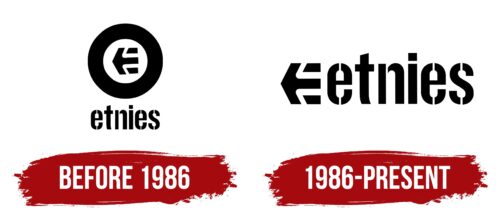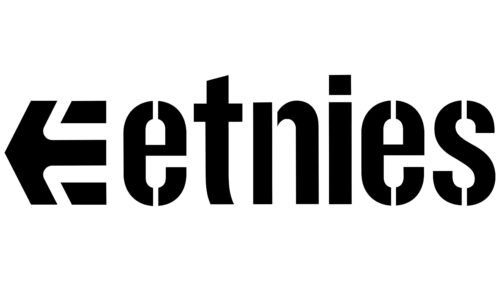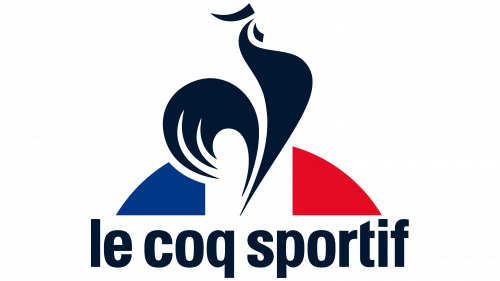The Etnies logo conveys a key message to its audience: pursue your goals despite difficulties and obstacles. The athlete’s direction is the only right; the brand’s emblem symbolizes this idea. The identity is complex, including multiple visual effects and techniques that create a deep meaning together. These elements allow the visual mark to convey important information, reflect the company’s philosophy, and emphasize its high status.
While the logo doesn’t stand out with bright colors, its minimalism and monochrome nature give it completeness and unity. It creates a clear impression and is filled with substantial specificity, enhancing its visual expressiveness and making the brand’s image cohesive.
Etnies: Brand overview
The history of the Etnies brand began in 1986 in France, founded by professional skateboarder Pierre André Senizerges. Originally named “Etnics,” the brand’s name was inspired by the word “ethnic,” reflecting its goal to cater to various subcultures, especially skateboarders. Senizerges, an avid skateboarder, noticed a lack of shoes designed specifically for skateboarding. At the time, most skaters wore regular sneakers that wore out quickly and didn’t provide the support or grip needed for skateboarding. This inspired him to create shoes tailored to the specific needs of skateboarders.
The first shoe, launched in 1986, was designed for skateboarding. It featured a reinforced upper for durability and a stronger sole for better grip on the skateboard. The model quickly became popular among French skateboarders and began to attract attention across Europe.
A pivotal moment came in 1989 when Pierre André Senizerges moved to California to expand the brand into the U.S. market, the global epicenter of skateboarding culture. Due to trademark issues in the U.S., the brand was renamed from “Etnics” to its current name.
The company experienced rapid growth in the early 1990s. The brand began sponsoring professional skateboarders, which significantly boosted its visibility. One of the first athletes to be sponsored was Natas Kaupas, whose 1991 signature shoe became one of the brand’s most popular models. In 1993, the product line expanded to include skateboarding apparel, such as pants, hoodies, and T-shirts, helping establish the company as a lifestyle label closely tied to the skateboarding community.
In 1995, Sole Technology, Inc. was founded as the parent company, allowing for better management and growth and the development of new labels for various extreme sports.
By the late 1990s, the brand began expanding internationally, setting up offices and distribution centers in Europe and Asia to boost sales and establish its presence in global markets.
The 2000s marked a period of continued innovation. In 2000, the company introduced STI Foam technology to improve cushioning and comfort in its shoes. This innovation was well-received by skateboarders and strengthened the brand’s reputation as a leader in skateboarding footwear technology. In 2003, the company expanded into winter sports by launching its first line of snowboarding shoes, catering to skateboarders who also enjoyed snowboarding during the off-season.
In 2006, the brand opened a skatepark in Lake Forest, California, one of the largest skateparks in the U.S. This initiative further deepened the company’s connection to the skateboarding community.
To celebrate its 25th anniversary in 2010, the company released a special collection of shoes and apparel, paying tribute to the brand’s legacy and its impact on skateboarding culture.
Between 2011 and 2015, several new technologies were introduced, including Evolution Foam for better cushioning and Geo-Hex for enhanced grip on skateboards, solidifying the company’s reputation for innovation. In 2016, the company launched its first line of cycling shoes, developed in collaboration with professional cyclists, which quickly gained popularity among BMX riders.
In 2018 and 2019, the company collaborated with various well-known brands and artists, helping expand its reach into street fashion while maintaining its core connection to skate culture.
Despite global challenges from 2020 to 2022, the company adapted by expanding its digital marketing efforts and strengthening its e-commerce platform. The brand continued to support the skateboarding community by sponsoring events and athletes.
By 2023, the company had solidified its position as a leading brand in the skateboarding and extreme sports industries. The business remains dedicated to the core values of skateboarding culture and continues to innovate in footwear and apparel as it grows globally.
The brand’s history illustrates how passion for sports and understanding of the audience can lead to success in the competitive market of sports footwear and clothing.
Meaning and History
What is Etnies?
This California-based footwear and apparel company has become a key player in global skateboarding culture. The brand, which combines street style with practicality, grew out of a passion for skateboarding and has become a lifestyle icon. The company is known for its high-performance, durable skate shoes that not only withstand the harsh conditions of skating but also feature creative designs that blend comfort and style. The brand has also expanded its range to include casual clothing and accessories while maintaining its recognizable vibe of coolness and functionality, appealing to people on and off the board.
Before 1986
The brand introduced its first logo, which immediately sparked increased interest from the potential audience. The identity was complex and multilayered. A textual element was placed on a white background, but it was not the main focus. The primary attention was drawn to the geometric shape and arrow positioned in the center, which served as the key focal point.
The symbols held significant meaning according to the creators’ intent and added a certain complexity to the design. The circle with a thick black outline acted as a frame for another symbol, representing infinity. Some saw this element as a target, while others perceived it as a metaphor for the company’s path to achieving its goals.
The arrow inside the circle consisted of three parts, with its sharp tip pointing to the left. For skateboarders, this symbol represented victories and achievements, explaining its importance in the identity created by Pierre André Senizergues, a well-known and successful skater in the past.
The company name was written in large, slightly rounded capital letters, placed on a single horizontal line, and equal in height.
1986 – today
The Etnies logo stands out for its simplicity, with each element conveying the brand’s philosophy. It consists of two key components: the recognizable arrow and the company name. The black-and-white color scheme emphasizes the design’s restraint and minimalism. The white background enhances the contrast, making the black elements noticeable and easy to interpret.
The arrow on the left symbolizes movement and forward momentum. Its multi-layered structure gives a sense of depth and dynamism, closely aligned with the spirit of skateboarding culture, which is deeply connected to the brand. The arrow represents speed and the freedom to choose one’s path, even if it is filled with obstacles.
The brand name on the right is written in a bold and solid font. The clear, heavy letters emphasize stability and confidence. An original touch is the partial fragmentation of some letters, adding a sense of movement and uniqueness. This highlights that the company does not conform to conventional boundaries, just like its audience—those who live at their own pace: skaters, surfers, and other active lifestyle enthusiasts.
The black color underscores strength and reliability, while the white background creates a sense of lightness and purity, making the logo stylish and modern. This visual balance reflects the harmony of strength and lightness, which is important to the brand.
Etnies became one of the first brands aimed at skateboarders and quickly gained recognition thanks to its innovative approach to footwear design. The emblem represents the company’s independent spirit and commitment to staying true to street culture.






